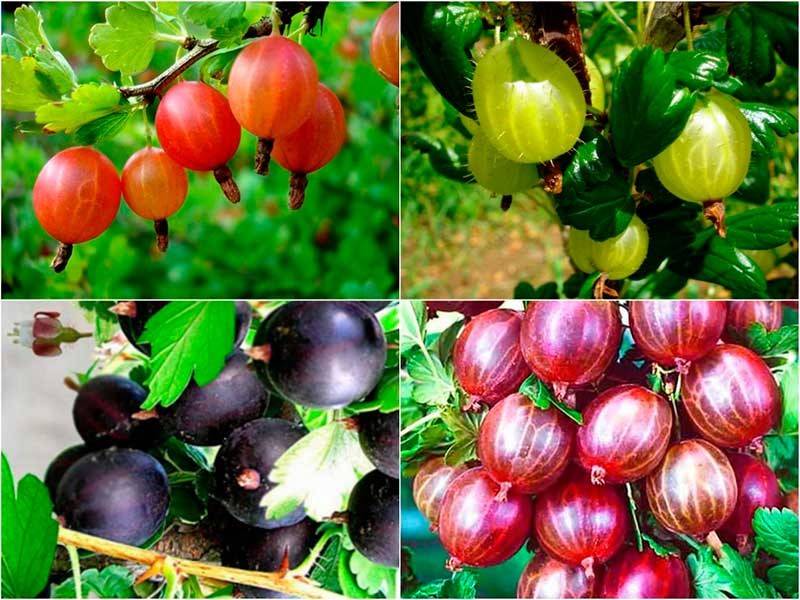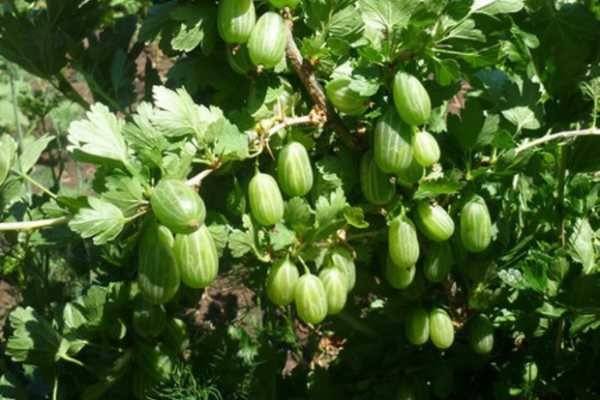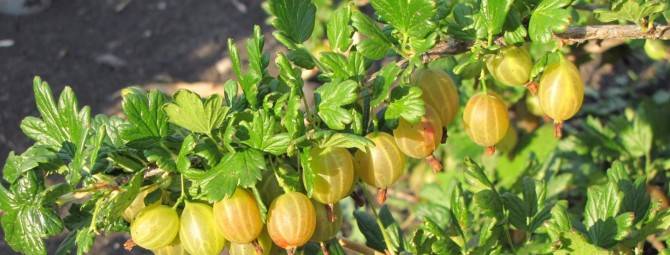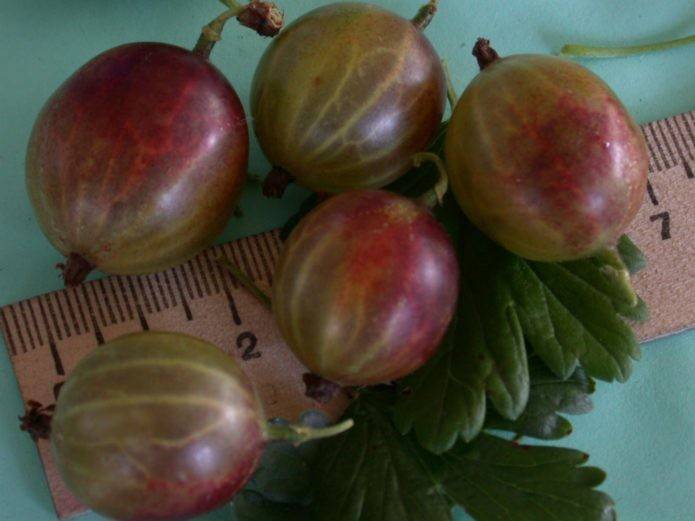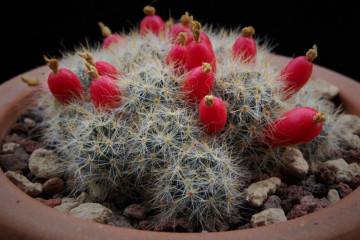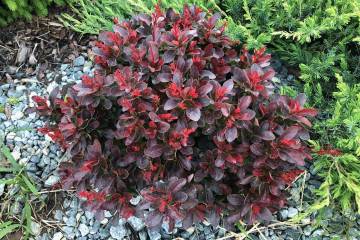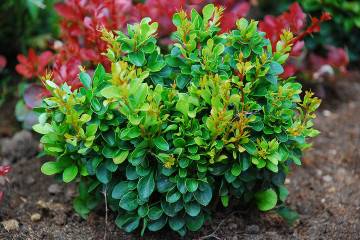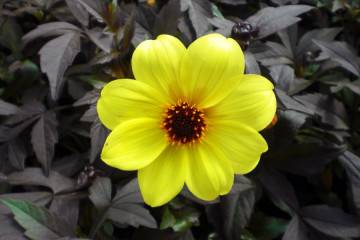Gooseberry varieties: a description of the best types of red, yellow, green
Content:
Even in Kievan Rus they knew and loved a berry called kryzhbersen or agryz. Now he is familiar to everyone as an ordinary gooseberry. It copes well with extreme conditions - a slight drought, loves sunlight in winter and is one of the first to bloom on the site. Breeders have bred many different varieties of this plant, which are quite different from each other. But the famous shaggy kiwi is called the Chinese gooseberry, which is not even a relative of the gooseberry!
On what grounds is it classified
Gooseberry varieties are classified according to various key characteristics.
The presence of thorns
The degree of "thorniness" of the branches determines the ease and speed of harvesting juicy berries. Protective needles in a plant may vary in length, thickness, color, direction and place of growth, or may be absent altogether.
Ripening terms
Conventionally, all types of this shrub by the ripening period are divided into:
- early (including mid-early) - flowering starts already in the first days of April;
- average. Bloom in mid-April;
- late (including mid-late). They bloom in May and never encounter recurrent frosts.
Sub-divisions are used for weather correction. To enjoy the harvest all summer long, it is enough to plant a couple of bushes of different ripening periods.
Self-fertility
If the gooseberry does not require a certain pollinator variety for pollination and the appearance of the ovary, it belongs to the category of self-fertile, otherwise self-fertile, for example, Record.
Gardeners try to grow mainly self-pollinated plants:
- Belarusian sugar;
- Russian;
- Plum;
- Change;
- Anniversary;
- Russian red;
- Prune;
- as well as gooseberries of varieties Masheka and Chelyabinsk green (their self-fertility is lowered).
Disease resistance
Almost all gooseberries are susceptible to disease with spheroteka - powdery mildew. However, two varieties have been bred that can resist this disease by 100 percent - Whitesmith (he also has very tasty berries, and the yield is up to 7 kg per bush) and Spinefree - late ripening, thornless. Hinnomaki, Smena and Pushkinsky are also able to resist this disease.
Contrary to stereotypes, gooseberry fruits are not only green, but also red, yellow, almost black, white and even purple. Such colors look great in jams, sauces and compotes, making them a decoration of the table.
Berries also surprise with a variety of forms:
- oval. The fruits of the gooseberry Harlequin, Grand, Altai numbered, Ural emerald, Sunny bunny have this shape;
- ball - Candy, Kazachok, Slavic;
- pear - Varshavsky, Dessertny, Zashchitnik, as well as Honey gooseberries;
- egg - Garkate, Golden Light, Leningrader, Anniversary, Black Negus;
- keg - Malachite.
Resistance to mechanical damage
The strength of the skin of the berry is very important for harvesting, transporting and storing the crop. The strongest are among the Russian red, Serenade, Jubilee. But the gooseberry Krasnoslavyansky, Chernomor, Kazachok, Shalun have fruits with a very delicate skin.
Green gooseberry varieties
Green fruits do not always mean their immaturity, often it is just a feature of the variety. At the stage of maturity, this color can boast:
- Baltic;
- Veteran (has strong large fruits);
- Emerald (very winter hardy);
- Fertile green;
- Ural emerald;
- Chelyabinsk green;
- Green rain (very resistant to wintering and drought).
Yellow gooseberry varieties
Fruits of a cheerful yellow color of various shades and degrees of color intensity grow on bushes of such varieties as:
- Altai license plate (distinguished by ruddy sides);
- Coral (very juicy, easily transportable);
- English yellow (bears fruit every year);
- Golden light;
- Amber;
- Honey. Its fruit tastes like flower honey and is only suitable for immediate consumption.
Red gooseberry varieties
Nature and breeders presented the bright rich red color of the skin to such varieties as:
- Ballet;
- Victoria;
- Candy (the name is associated with the sweetness of the fruit);
- Ksenia - standard gooseberry;
- Charm;
- Masheka has an increased immunity to powdery mildew;
- Red triumph;
- Redball.
Highest-yielding varieties
Productivity is measured in kilograms of fruits harvested from one bush and is determined not only by varietal characteristics, but also by agrotechnical care, the growing climate and the composition of the soil on which the bush grows. Gardeners call the most high-yielding plants:
- Industry;
- Houghton;
- Date;
- English yellow;
- Bottle green;
- Lemon gigantic.
Large-fruited gooseberry
Most gardeners prefer the varieties with the largest berry size, while the average weight of regular gooseberries with good care is 5-6 grams.
Nowadays, large-fruited species include:
- gooseberry beryl;
- gooseberry date;
- gooseberry White triumph;
- gooseberry Spring;
- People's;
- Favorite;
- Plum (berry weight is approaching 7 grams).
Gooseberry without thorns
The main advantage of the bushes is the ease of harvesting and safety for children. At the same time, the taste of the fruits is rather mediocre, the yield is also not very high. The absence of thorns can please:
- Gulliver ;.
- Consul (its berries are distinguished by a high content of vitamin C);
- Matveevsky;
- Eaglet;
- Redball has good immunity against disease.
Ripening classification
Modern gooseberry varieties can ripen at very different times.
Early ripe
The ripening period of the crop falls on early-mid June:
- Yarovaya gooseberry;
- Grandee;
- Affectionate (the name is determined by its lack of tenacity);
- Tender;
- Pax - blooms before everyone else, in early April;
- Favorite.
Mid-early varieties (end of the first-beginning of the second summer month) include:
- Sadko bears fruit from the 20th of June;
- Minx is pleasant in all respects: there are no thorns, it is resistant to frost and diseases, the berries are small, but the vitamin C content is high - 47.5 mg per 100 g.
Mid-season
Ripening period falls on mid-end of July:
- Nekrasovsky;
- gooseberries of the Belarusian selection Mashenka;
- Purman;
- Souvenir.
This group also includes mid-late varieties (the harvest ripens in the last week of July):
- Aristocrat;
- Captivator;
- Romance;
- The sun bunny is a very hardy variety but needs pruning.
Late ripening
They delight gardeners with ripe berries in early August:
- Korshudin;
- Defender (terribly prickly species with excellent yields);
- Mukurines;
- Pokrovsky;
- Serenade.
Varieties for different climatic conditions
In our country, difficult and varied climatic conditions - from the hot south to the harsh Siberia, therefore, the survival of the plant in one or another growing strip is put in the first place.
For southern latitudes
For such conditions, drought-resistant plants are selected. It:
- Kubanets;
- Russian;
- Kuibyshevsky.
For middle latitudes
The climatic conditions in these zones are favorable for the growth of gooseberries, but frosts and recurrent frosts also occur.
The best gooseberry varieties for the Central Black Earth Zone will be:
- Plum;
- Anniversary;
- Krasnoslavyansky;
- Kazachok;
- Chernomor;
- Sirius (Gulliver);
- Serenade.
Suitable for the Moscow region:
- White Nights;
- Moscow red;
- Invicta;
- Grape (Russian);
- Date;
- Beryl;
- Hinnonmaki (Finnish selection);
- Belarusian sugar;
- gooseberry Northern Captain.
For the Middle Volga and Lower Volga regions, the following are recommended:
- Ural grapes;
- African;
- Our sugar.
The best varieties for northern latitudes
Growing gooseberries here is quite an extreme activity due to the very harsh natural conditions. In the north, winters are very cold and summers pass quickly. In such conditions, the shrub must be frost-resistant and resistant to fungal infections. All varieties are characterized by small berry sizes:
- Pioneer;
- Seedling Lefort;
- Change;
- Firework;
- Mid-season Finnish;
- Finnish red;
- Hinnonmainen Keltainen.
How to choose the right variety
When choosing the best variety, it is necessary to focus on its adaptation to local climatic conditions (you can immediately take resistant Siberian species). There is always an opportunity to plant new interesting bushes to those already growing on the site, they get along well and can give new combinations of tastes with mutual pollination.
Gooseberries are very popular in our country, they are consumed both raw and in the form of preparations - jam, compotes, etc. More than 160 varieties of this plant have been bred. They vary in color, berry shape, fruiting timing and disease resistance. The most adapted varieties can be selected for each climatic zone.
